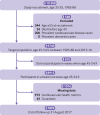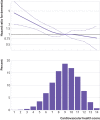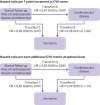Association of ideal cardiovascular health at age 50 with incidence of dementia: 25 year follow-up of Whitehall II cohort study
- PMID: 31391187
- PMCID: PMC6664261
- DOI: 10.1136/bmj.l4414
Association of ideal cardiovascular health at age 50 with incidence of dementia: 25 year follow-up of Whitehall II cohort study
Abstract
Objectives: To examine the association between the Life Simple 7 cardiovascular health score at age 50 and incidence of dementia.
Design: Prospective cohort study.
Setting: Civil service departments in London (Whitehall II study; study inception 1985-88).
Participants: 7899 participants with data on the cardiovascular health score at age 50.
Exposures: The cardiovascular health score included four behavioural (smoking, diet, physical activity, body mass index) and three biological (fasting glucose, blood cholesterol, blood pressure) metrics, coded on a three point scale (0, 1, 2). The cardiovascular health score was the sum of seven metrics (score range 0-14) and was categorised into poor (scores 0-6), intermediate (7-11), and optimal (12-14) cardiovascular health.
Main outcome measure: Incident dementia, identified through linkage to hospital, mental health services, and mortality registers until 2017.
Results: 347 incident cases of dementia were recorded over a median follow-up of 24.7 years. Compared with an incidence rate of dementia of 3.2 (95% confidence interval 2.5 to 4.0) per 1000 person years among the group with poor cardiovascular health, the absolute rate differences per 1000 person years were -1.5 (95% confidence interval -2.3 to -0.7) for the group with intermediate cardiovascular health and -1.9 (-2.8 to -1.1) for the group with optimal cardiovascular health. Higher cardiovascular health score was associated with a lower risk of dementia (hazard ratio 0.89 (0.85 to 0.95) per 1 point increment in the cardiovascular health score). Similar associations with dementia were observed for the behavioural and biological subscales (hazard ratios per 1 point increment in the subscores 0.87 (0.81 to 0.93) and 0.91 (0.83 to 1.00), respectively). The association between cardiovascular health at age 50 and dementia was also seen in people who remained free of cardiovascular disease over the follow-up (hazard ratio 0.89 (0.84 to 0.95) per 1 point increment in the cardiovascular health score).
Conclusion: Adherence to the Life Simple 7 ideal cardiovascular health recommendations in midlife was associated with a lower risk of dementia later in life.
Published by the BMJ Publishing Group Limited. For permission to use (where not already granted under a licence) please go to http://group.bmj.com/group/rights-licensing/permissions.
Conflict of interest statement
Competing interests: All authors have completed the ICMJE uniform disclosure form at http://www.icmje.org/coi_disclosure.pdf (available on request from the corresponding author) and declare no support from any organisation for the submitted work other than the grants reported in the funding section above; no financial relationships with any organisation that might have an interest in the submitted work in the previous three years; no other relationships or activities that could appear to have influenced the submitted work.
Figures



Comment in
-
Life's Simple 7 likely to be associated with dementia risk reduction in both midlife and older age groups.BMJ. 2019 Sep 12;366:l5491. doi: 10.1136/bmj.l5491. BMJ. 2019. PMID: 31515223 No abstract available.
References
-
- Lloyd-Jones DM, Hong Y, Labarthe D, et al. American Heart Association Strategic Planning Task Force and Statistics Committee Defining and setting national goals for cardiovascular health promotion and disease reduction: the American Heart Association’s strategic Impact Goal through 2020 and beyond. Circulation 2010;121:586-613. 10.1161/CIRCULATIONAHA.109.192703 - DOI - PubMed
Publication types
MeSH terms
Grants and funding
LinkOut - more resources
Full Text Sources
Other Literature Sources
Medical
